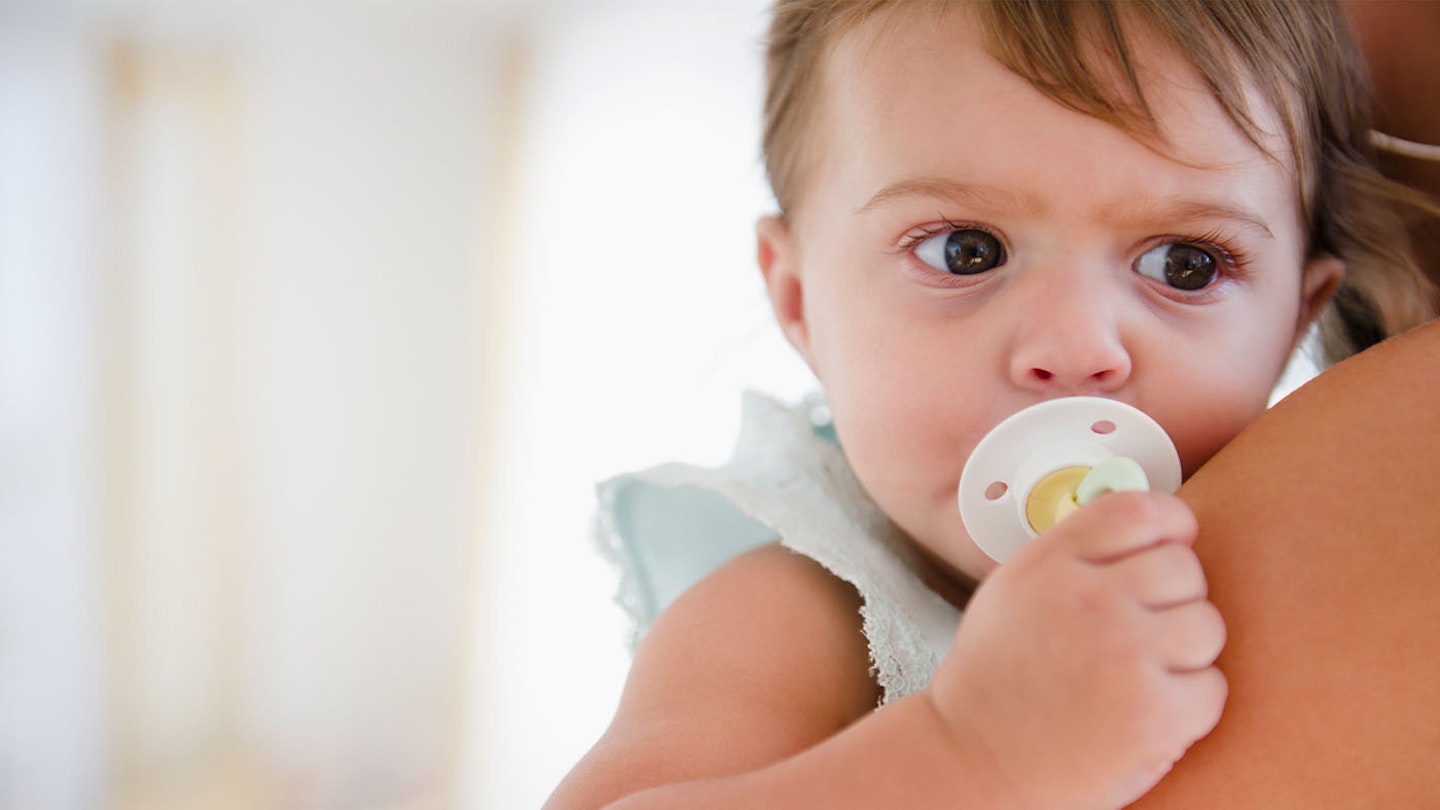Deciding whether to use a pacifier for a fussy baby can be a big question for some moms, but what’s often harder is deciding which one to choose.
If your baby is breastfed, then you’ll want to find the right kind of pacifier to suit a breastfeeding baby.
All babies find suckling a comfort, meaning a pacifier is a great solution if your baby is unsettled, fussy, or reluctant to sleep. The majority of babies find a pacifier soothing; and, science backs up their use, with the American Academy of Pediatrics recommending the use of a pacifier to reduce the risk of SIDS (Sudden Infant Death Syndrome). They can be an absolute godsend to parents and guardians who want to soothe an unsettled baby quickly and easily.
The best pacifiers for newborns
• Best overall pacifiers for breastfed babies: MAM Comfort Baby Pacifier, $8.97
• Best hospital-grade silicone pacifiers for breastfed babies: Philips Avent Soothie, $8.94
• Best orthodontic pacifier for breastfed babies: NUK for Nature™ Orthodontic Pacifier, $12.99
It is recommended that breastfeeding is established before introducing a pacifier to your baby, to make sure they accept it without interrupting your feeding routine.
There are so many pacifiers available to buy and surely they’re all the same? Sadly, no. But we’re here to help you find the right pacifier for you and your baby, based on parent reviews and expert opinions.
How we chose these pacifiers
The Mother&Baby Awards parent testers are provided with some guidelines while testing, so that they take into consideration four key areas: usability, design, quality and value for money. We ask them to score each of these out of 10, as well as give their overall impression of the product.
Find out more about how we test products for Mother&Baby.
In the UK, our Mother&Baby awards are renowned in the industry for being one of the most highly respected product awards for baby and parenting products, and every year, we arrange for thousands of independent mum reviewers to test the latest products on the market. You'll find any M&B award-winners that are available to buy in the US in our round-up below.
The best pacifiers for breastfed babies
Best overall pacifiers for breastfed babies
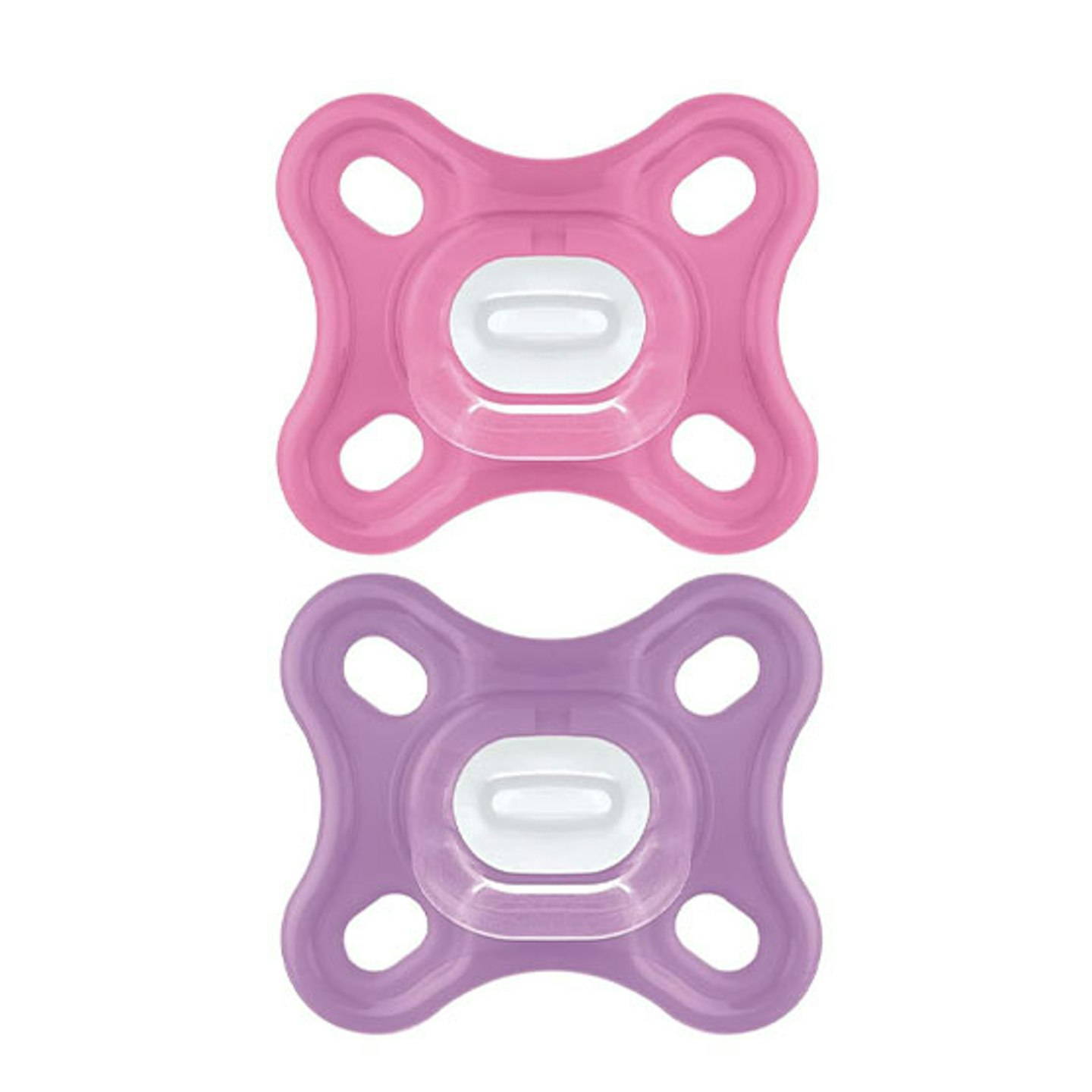
The MAM Comfort Pacifier was developed in collaboration with leading paediatricians, nurses and speech therapists.
It features an extra-small teat to help your baby’s natural suckling action, and it respects the development of your baby’s mouth and teeth. This pacifier is extremely lightweight and super soft, meaning it’s gentle on that newborn skin. Made from 100% silicone, in one piece, meaning it’s easier to keep clean and safe than pacifiers made from more than one piece. The shape of this pacifier means there’s no right way round - if it drops out of your baby’s mouth, it’s easy to pop back in without fussing. There are also air holes meaning plenty of air circulation to look after your baby’s skin.
We love that this pacifier comes in its own sterilizer box, which you can pop into the microwave for three minutes to sterilize.
This product won bronze at the Mother&Baby awards 2023 for best product for a newborn.
Our M&B tester said: “The thing that I liked the most about the product was the shape and size of the teat. When my son used this product I didn’t feel that his mouth or teeth would be affected by it. The product is durable, which was good as my son constantly likes to spit his pacifiers out onto the floor!”
Read our full MAM Comfort Soother review.
Pros
- 100% silicone
- Air holes
- Comes with sterilizer box
- Available in three colors
- Small teat for newborns
Cons
- Suitable for a short time due to small teat
| Material: | Silicone |
| Age range: | 0-3 months |
Best hospital-grade silicone pacifiers for breastfed babies
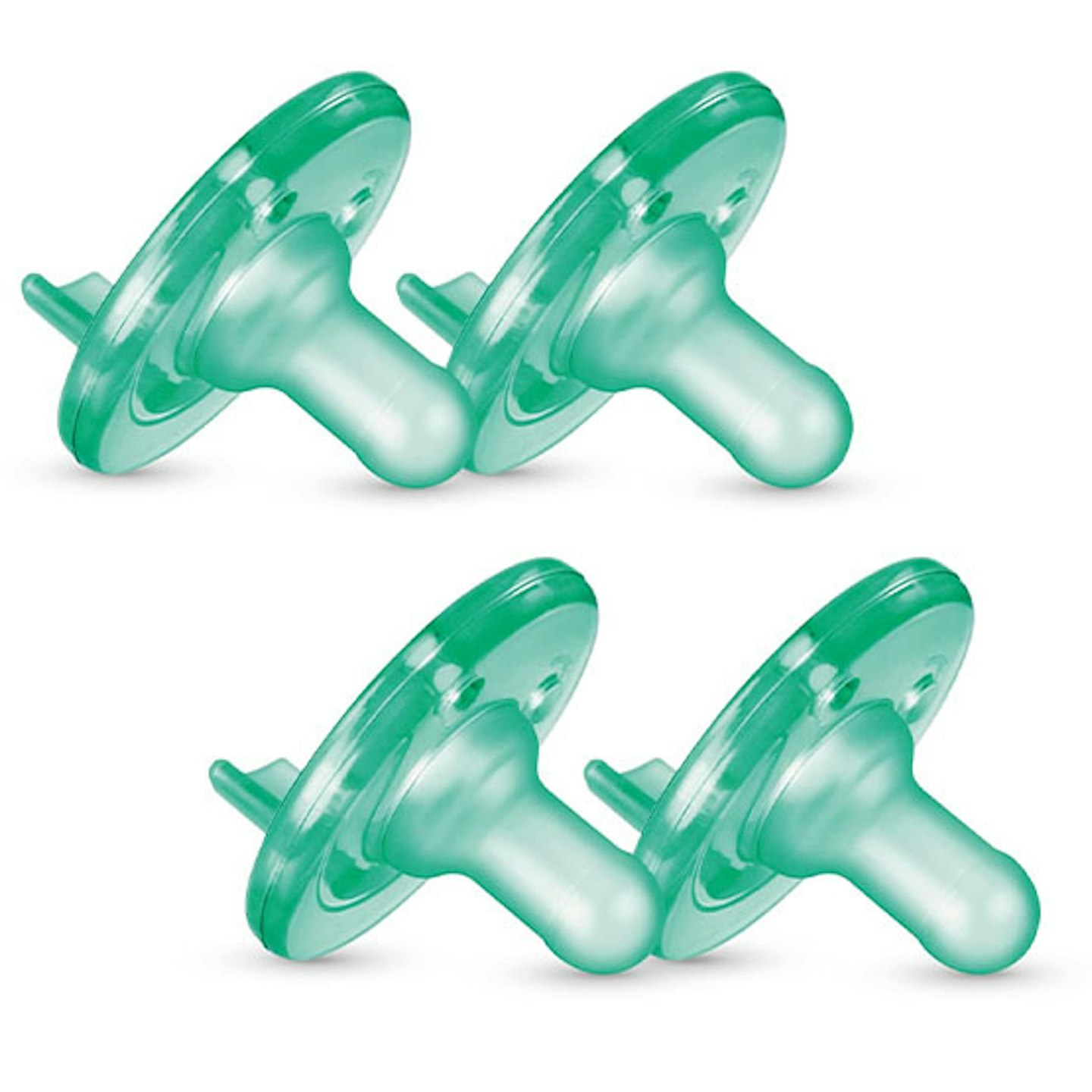
A popular pacifier, which you might have been given if you had your baby in hospital - it tends to be the choice of doctors and midwives, as well as thousands of parents. It’s molded from just one piece of medical-grade silicone, meaning it’s easy to clean and safe for your baby. The orthodontic design means using it won’t affect your baby’s tooth development. The hole in the center of the pacifier means you can use your finger inside to help your baby latch on to it; this is great for bonding with your baby as it keeps you close. Suitable from birth, this is the 0-3 months version; there is also a version for older babies from three months, made from a stiffer silicone. We’ve included links to buy, but they’re also widely available from drug stores too - so it’s easy to pick one up while doing your grocery shopping.
**This product won bronze at the Mother&Baby awards 2022 for best product for a newborn.
**
M&B mum tester Louise said: "I think this is a stand-out product, (no pun intended!). The glow-in-the-dark feature makes it so quick and easy to locate the soother during the night, thereby increasing the chances of my baby returning to sleep. When using a previous product I had to turn on the lights which resulted in everyone waking up. The feature also works all night long without having the bother of charging it, which is always a plus."
Read our full review of the Philips Avent Soothie
Pros
- Made from one piece of silicone
- Easy to clean
- Widely available
- Doctor recommended
- Two sizes
- Dishwasher safe
Cons
- Limited range of colors
| Material: | Silicone |
| Age range: | 0-3 months |
Best orthodontic pacifier for breastfed babies

These pacifiers are specifically designed to look after your baby’s palate and tooth development; but not only that, they’re sustainable too. They’re made from 100% sustainable plastic using renewable resources. The design mimics a mom’s nipple, meaning it’s easier for your baby to get used to using this pacifier. They’re available in a range of colors, and two sizes: 0-6 months, and 6-18 months. The shape of the pacifier is designed to sit just underneath your baby’s nose, meaning they can breathe easily while it’s in place.
Review: “This is literally the only pacifier my baby would take. We didn’t discover it until he was already 4 months old, but I wish I had tried it sooner. It helped soothe him at night when he didn’t need a bottle. We tried other Nuk pacifiers and somehow my little one knew they were different, even though the nipples were the same.”
Pros
- Orthodontic design
- Sustainable plastic
- Two sizes
Cons
- May be too large for newborns
| Material: | Plastic |
| Age range: | 0-6 months |
Best BIBS pacifiers for breastfed babies
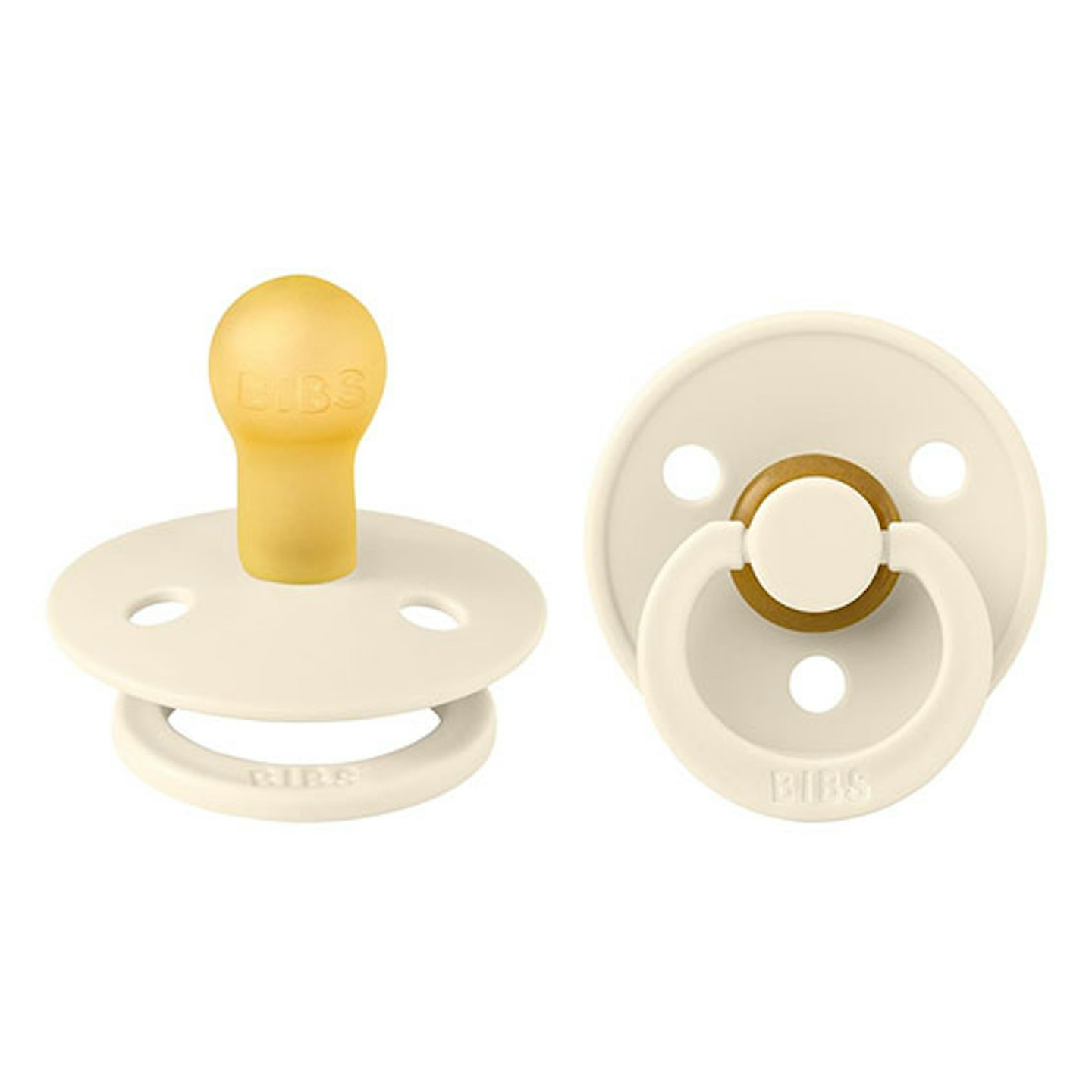
BIBS binkies have been famous and popular for more than 40 years, thanks to their stylish and iconic circular design. They’re ideal pacifiers for newborn babies, with a natural rubber nipple, and come in a range of beautifully stylish colors. The rubber means they are sustainable, although you might find they degrade sooner than silicone pacifiers. They’re not made from one piece, however, so they can be harder to clean than other pacifiers made in one piece.
Review: “This is my baby’s favorite binky. I had to buy more to keep all over the house, car, bedroom. It’s a little smaller than the infant one and she seems to prefer the newborn, but she likes this one as well. Doesn’t fall out as easily as other pacifiers because of the bulb shape at the end. Buy it!”
Pros
- Stylish
- Iconic
- Natural rubber
Cons
- Difficult to clean
- Pricy
| Material: | Natural rubber |
| Age range: | 0-6 months |
Best pacifiers for sleeping
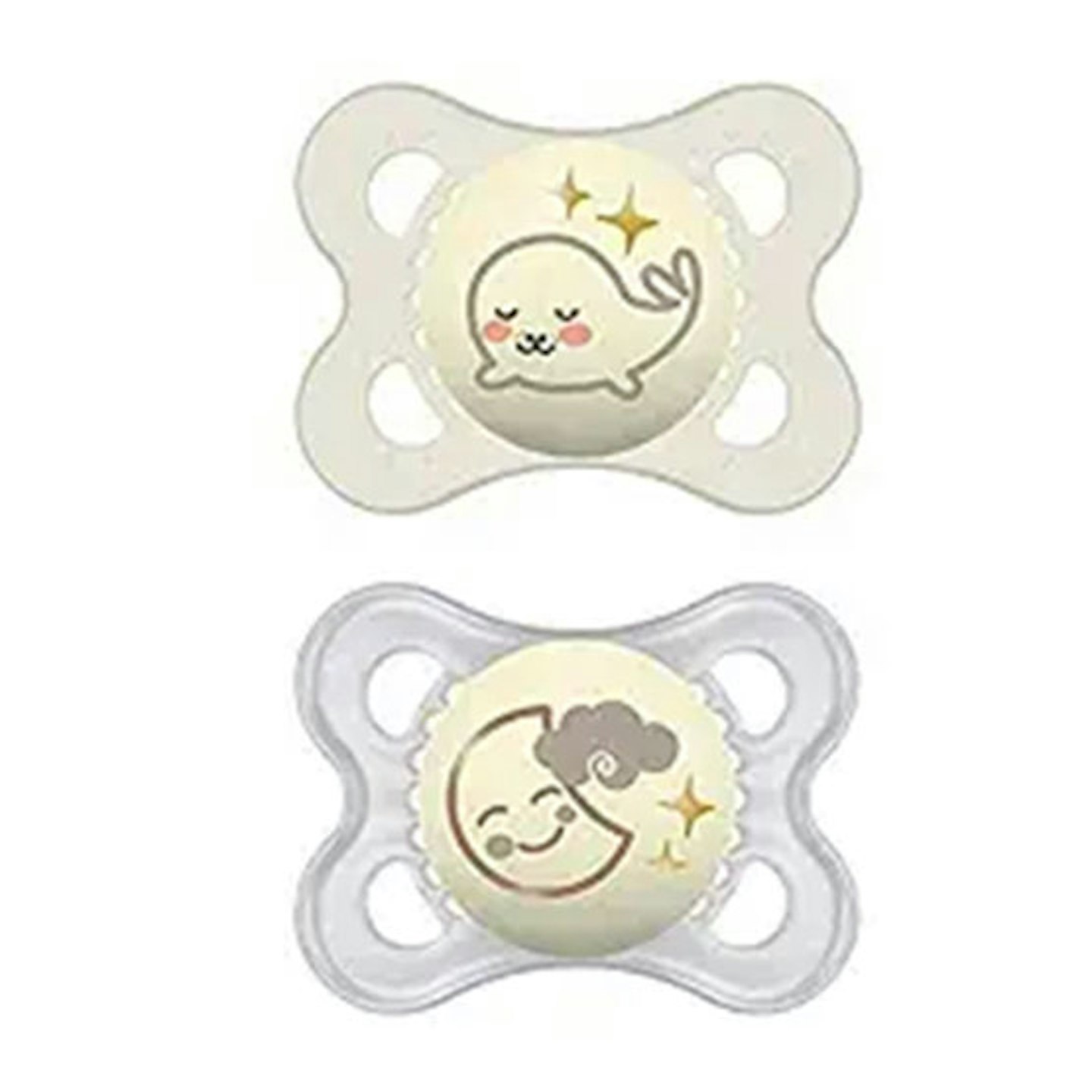
We love these MAM Night Pacifiers for bedtime for one simple reason: if they drop out of your baby’s mouth during the night, they’re easy to find again as they glow in the dark. This is great for us sleep-deprived moms, as we don’t have to root around for ages looking for it, but also for babies when they get a little older and can find it themselves in the dark. Win-win. That’s not the only reason to buy these pacifiers for newborns, though. They’ve been designed with paediatricians, dentists and orthodontists, and the brand says they are accepted by 94 per cent of babies. They have a wide design, with air holes, looking after your baby’s newborn skin. They also come with their own sterilizer box, meaning they’re safe in your purse on the go, and easy to sterilize in the microwave in three minutes.
Review: “Glow in the dark pacies are the only kind that will ever come into my house! They are a game changer!! Also love the comfortable shape of the pacifier and all 3 of my boys have loved them! Especially love how light they are for the newborn stage, some infants can’t hold those heavy hospital grade pacies in their mouths very easily.”
Pros
- Glow-in-the-dark
- Comes with sterilizer box
- Air holes
- Available in a range of colors and designs
Cons
- One size
| Material: | Silicone |
| Age range: | 0-6 months |
Best ultra-light pacifiers for breastfed babies
One of moms’ biggest concerns about using a pacifier is the impact on oral development, but with these lightweight pacifiers your worries are gone. Your baby’s tongue and jaw can sit naturally, thanks to the symmetrical design, and they’re unbelievably lightweight - which should, hopefully, mean they drop out of your baby’s mouth less frequently. The soft, silicone nipple-like pacifier is said to be accepted by more than 97% of babies, according to Tommee Tippee. The shape of the pacifier is kind on your baby’s skin, together with the air holes to keep air circulating. They’re also dishwasher-safe and easy to clean.
Review: “My breastfed baby refused all pacifiers, I tried so many brands and different nipple shapes and she wouldn’t touch any of them, while looking for new ones to try I came across these and saw all the reviews saying how good they were and let me tell you they are truly magic, not only do they stay in her mouth but she accepted them immediately and LOVES them!! They are so lightweight and easy to clean since they are one solid piece of silicone! I would highly recommend these to anyone with a breastfed baby or anyone whose baby struggles to keep a pacifier in!”
Pros
- Extremely lightweight
- Orthodontic design
- One piece
- Easy to clean
Cons
- Pricier than some pacifiers
| Material: | Silicone |
| Age range: | 0-6 months |
Best BIBS glow-in-the-dark pacifiers for breastfed babies

BIBS pacifiers are popular across the US and the rest of the world, and it’s easy to see why. They look great as well as being super soothers for your babies. This Boheme Collection features glow-in-the-dark handles, meaning they’re easy for sleepy moms to find them in the night, and for your baby to learn to pick up too; plus, the iconic handle is easy for baby to hold and grip, too. BIBS have been making these famous pacifiers for more than 40 years. This design is an upgrade from the famous round BIBS design, and we love its stylish, neutral tones. Practical baby products can be stylish, too.
Review: “We are a BIBS pacifier family! This was the only brand my daughter would take when we had her, so I bought a set for my son when he was born. He is almost 2 months now and won't take any binky except BIBS. I love that the plastic part of the pacifier comes out and away from the baby's face. He doesn't get little indentations on his cheek like other binkies would leave. The binky is also light enough that it stays in his mouth even when he's not actively sucking on it. The shape and size of the nipple is perfect and I like that they sell binkies in stages based on age. An added bonus: these are the cutest binkies I've found, and they come in the most aesthetic color combinations.”
Pros
- Made from latex rubber
- Available in a range of designs and sizes
- Glow-in-the-dark
- Easy to hold
- Stylish
Cons
- May need replacing sooner than other makes
| Material: | Natural rubber |
| Age range: | 0-6 months |
The best pacifier and teether for breastfed babies
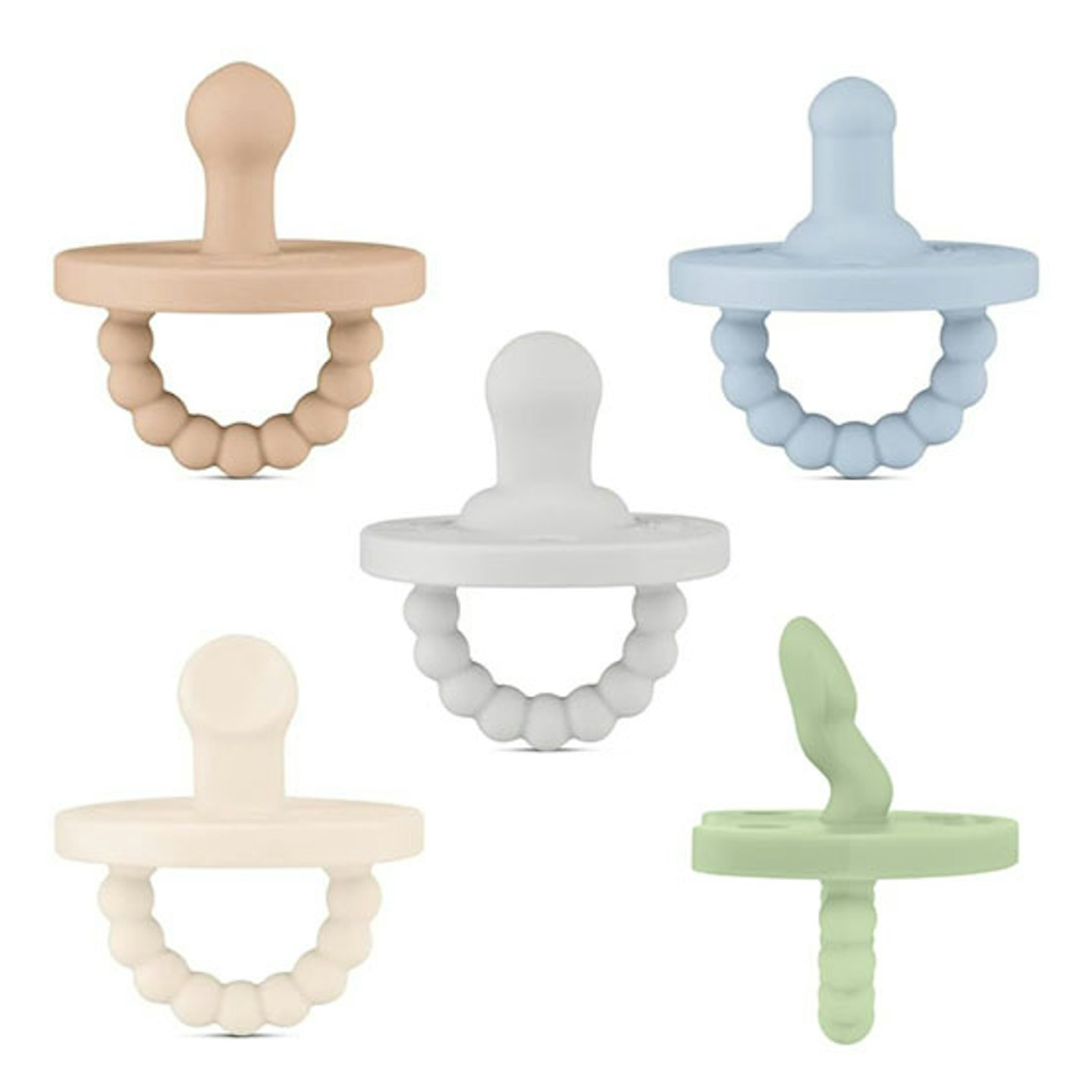
We love a baby product that does more than one job, and this pacifier fits the bill as it is also a teether. They’re super cute and stylish to look at, as well as being practical and soothing for your breastfed baby. Once your baby has started to teeth, you often find their normal pacifier breaks and tears. This pacifier is designed to do both things, and is designed to be sturdy and hard-wearing. It is pricier than other binkies on the list, but as it doubles up as a teether too, we think it’s worth the spend. This starter kit that we’ve chosen covers all ages for your baby; there are five different nipple designs, for every stage, and preference: Smile (Sage) for 0-24 months; Flat (Grey) for 0-24 months; Slant (Ivory) for 0-6 months; Round Stage 1 (Blue) for 0-6 months; and Bulb (Tan) for 0-6 months. That means if your baby is a bit fussy, there are plenty to choose from.
Review: "I love these pacifiers. We have 2 others at our house that are the regular size. My daughter was born at 37 weeks at just over 5 pounds. The normal size pacifiers are too big. But this one she is able to use and keep in her mouth! I can’t use the other pacifier that comes in the package since it’s too small (meant for a 35 week old baby or younger). The color is just like described and the quality is amazing!:) would definitely purchase again!"
Pros
- Stylish
- Dual-purpose
- Doubles up as a teether
- Variety of nipple designs
Cons
- Pricier than a standard binky
| Material: | Silicone |
| Age range: | 0-24 months |
Choosing the right pacifier for you and your baby
With so many pacifiers for newborns to choose from, there are some important features to bear in mind when deciding which one is right for your baby.
The pacifiers for your breastfed baby should always be BPA- and phthalate-free. It’s important to make sure they are designed and recommended by orthodontists, to ensure the good development of your baby’s oral health. The AAP recommends the use of pacifiers to prevent against SIDS, and it also recommends against using any type of pacifier clip that attaches on to your baby’s clothes or elsewhere.
Pay attention to the design of the outside of the pacifier, as well as the teat; your baby’s nose should be clear to ensure easy breathing, and air holes will help keep baby’s skin healthy. They should always be odor and taste-free, too.
When buying a pacifier for your newborn, consider the following:
Material
Look for a pacifier that’s made from latex or silicone, and it should be 100% BPA- and phthalate-free. Be aware that latex might not last as long as silicone.
Age range
Always check the age range when you’re buying a pacifier for your newborn, as brands often make larger, stiffer pacifiers for older babies, which your newborn might not accept as easily. Most pacifiers come in age ranges of 0-6 months and above, but always check before you purchase.
Teat shape
The shape of the teat is important, especially if you’re looking for a pacifier for a breastfed baby, as it needs to mimic the shape and feel of mom’s nipple. Most pacifiers are designed with the nipple in mind, and it can take a bit of trial and error to find a binky that your baby thinks is the same shape as your nipple.
Orthopedic pacifiers tend to be flatter, rather than a round teat, meaning they’re designed to feel the same as when baby is breastfeeding and so they will suck in the same way.
Cleaning
How easy is the pacifier to clean? Some come with their own travel boxes that can be used as their own sterilizers, making your life as a mom a little easier. It’s a good idea to read reviews to see how easy other parents have found cleaning them. We’d always recommend sterilizing pacifiers for newborn babies; when your baby is older, you can wash them with hot, soapy water.
Breathability
Air holes on the outside of the pacifier mean your newborn baby’s delicate skin will stay healthy.
Should you use a pacifier for breastfed babies? Is it safe?
Yes, it is safe for your baby to use a pacifier, and their use is recommended by the AAP to help prevent SIDS.
It’s safe for your breastfed baby to use a binky while they sleep, as well as during the day.
Many hospitals and premie units will use pacifiers, so often you’ll want to use the same brand of binky they were introduced to in hospital.
Babies use suckling as a way to soothe themselves, whether that’s your breast or a pacifier. If you’re breastfeeding your baby, you already know that your boob settles your tot. A pacifier will do the same, especially during fussy, unsettled moments or if your baby is unwell.
If you are breastfeeding your newborn, we recommending not introducing a binky until feeding is well established - normally about six weeks - to make sure feeding isn’t interrupted by the use of a pacifier.
Pros of using pacifiers for breastfed babies
• Pacifiers can prevent your baby from sucking their thumb
• Pacifiers can calm your baby
• You can use a pacifier to distract your baby during vaccinations
• If your baby has colic, using a pacifier can keep them calm
• Most premature babies are given a pacifier.
Cons of using pacifiers for breastfed babies
• Sometimes pacifiers can interfere with breastfeeding; to avoid this, you need to make sure your baby is feeding well and gaining weight before introducing a pacifier
• It can be really hard to break the habit of using a pacifier
• If your baby uses a pacifier all day, it can be harder for them to communicate with you or begin to make sounds
• Your baby could suffer from 'nipple confusion' as they struggle to transition between using the pacifier and breastfeeding. A sign of this could be difficulty latching on whilst breastfeeding.
To ensure your pacifier is safe, always check regularly for any signs of wear and tear, such as cracks or tears. Do this more frequently if the pacifier is made from rubber or latex, rather than silicone.
It’s not recommended to use any type of clip or ribbon to attached the pacifier to your baby’s clothing, as they can get tangled around your baby.
Don’t dip the pacifier in any food or drink before giving it to your baby.
Regularly sterilize the pacifier, especially during the newborn stage, and allow time for them to dry out properly after sterilizing and cleaning. There are lots of handy travel sterilizers available, meaning you can clean them when you’re on the go, too.
Are pacifiers good or bad for babies? What about their teeth?
Pacifiers aren’t bad for your baby, and there’s lots of evidence to show they are helpful at soothing your baby, and can reduce the risk of SIDS.
It’s personal preference as to how long your baby uses a pacifier, although orthodontists tend to recommend giving up pacifiers once your baby starts teething. Most binkies are now designed with orthodontists' recommendations to make them safer for oral development. Long-term use of a pacifier beyond the teething stage can impact on the position of teeth, and can impact on speech development. If your baby uses a pacifier for a large portion of the day, you might find they don’t start making noises or communicating as soon as without.
How do you clean a pacifier?
Sterilizing and properly cleaning pacifiers is important, especially during the newborn stage. Bacteria can build up and be very harmful.
Lots of pacifiers come with their own sterilizer box, which can be popped into the microwave for three minutes.
Other ways of sterilizing pacifiers include using sterilizing tablets, or placing the binkies in boiling water for several minutes. Always make sure they dry and cool completely before giving them back to your baby.
Once your baby gets a little older, you can pop them in the dishwasher or use hot and soapy water to wash them (always check they are dishwasher safe first).
Can you use a pacifier overnight?
Yes, your baby can keep their pacifier in overnight. The AAP recommends their use to help prevent SIDS, and it doesn’t matter if the binky drops out while they sleep.
Oftentimes, moms can worry about needing to stay away in order to pop the pacifier back in if your baby drops it, but you don’t need to. Normally babies will continue to sleep once it drops out. Once baby gets a bit older, a glow-in-the-dark pacifier can make it easier for babies to find and pop back in themselves. These glow-in-the-dark binkies are good for moms and dads too, as they save you searching around in the dark.
How to get your baby to take a pacifier
It can take some babies a while to get used to using a pacifier, and some babies simply don’t like them at all and never accept them - that’s OK too.
One of the best ways to introduce your baby to a pacifier is after a feed, when they’re starting to drop off to sleep, simply pop the pacifier into their mouth and let them suckle. Hold your baby in the same breastfeeding position while they’re drifting off to sleep.
Sophie Knight is a journalist and mum of two, and previously edited motherandbaby.com before moving on to write about family cars for Parkers.co.uk - now Sophie is Commercial Content Editor for M&B, Closer, Heat, Empire, Yours, Garden News, and WhatsTheBest.co.uk
